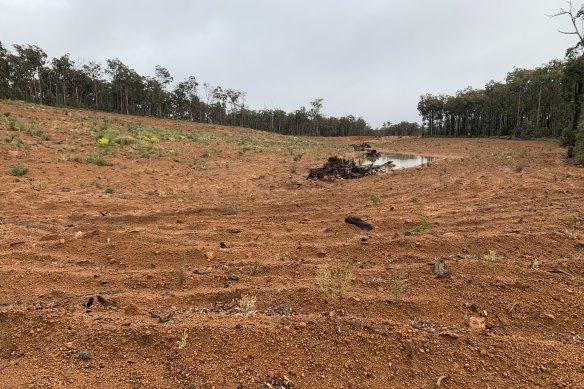This was published 2 years ago
Alcoa in WA: 60 years, 28,000 hectares of forest cleared, zero rehabilitation completed
By Peter Milne
US aluminium producer Alcoa has failed to fully rehabilitate any of the almost 28,000 hectares of Western Australian forest it has cleared during 60 years of mining, despite repeatedly stating it has rehabilitated more than 75 per cent of the area.
None of the 27,860 hectares of native vegetation cleared by Alcoa up to 2021 have been found to meet the government’s rehabilitation completion criteria, according to WA’s Department of Biodiversity, Conservation and Attractions.

This area near Nanga Brook, as seen in August 2021, has been rehabilitated, according to Alcoa.Credit: ARC Centre for Mine Site Restoration
Even 1355 hectares of its original mining area in Jarrahdale that Alcoa handed back to the state in 2005 and 2007 did not meet the criteria.
A DBCA spokeswoman said this land was accepted by the government as meeting criteria appropriate for the handover.
“This does not necessarily equate to all of the rehabilitation completion criteria applicable to the suite of different ages and types of rehabilitation present in the area at the time, having been met,” she said.
Jess Beckerling, director of not-for profit conservation group WA Forest Alliance, said the department’s finding that there was a lack of any completed rehabilitation was a shocking indictment of Alcoa’s attitude to the forest.
“The community is wising up to this sort of cynical greenwashing and Alcoa’s reputation and social licence to operate have taken a serious hit,” she said.
The discrepancy between Alcoa’s claims and what it has achieved is muddied by the use of conflicting definitions of rehabilitation by Alcoa and the government.
An Alcoa spokeswoman said it reported an area as rehabilitated after “landscaping, overburden and topsoil return, contour ripping, fauna habitat return, and seeding”, was done. This is the first 12 months of work towards meeting detailed rehabilitation competition criteria agreed with the WA government, which also included requirements for vegetation diversity and numbers after five and 12 years.
Professor Kingsley Dixon, director of the ARC Centre for Mine Site Restoration at Curtin University, said Alcoa’s definition of “rehabilitated” was correct among experts in the field but inconsistent with the understanding of the term by the general public.
“The community believes rehabilitation equals a forest ecosystem, but the reality is, that is not what is achieved at this stage,” he said.
Alcoa reports the area it calls rehabilitated to the Department of Biodiversity, Conservation and Attractions, and the numbers have appeared in many answers to questions in the WA parliament but without the accompanying definition.
The miner also reports the areas in its annual sustainability report with the description “returned to natural conditions”.
Neither party wanted to accept responsibility for reporting areas as rehabilitated using a definition inconsistent with the public’s understanding of the word.
The Alcoa spokeswoman said the company agreed on the definition with the department of biodiversity, and it was consistent with usage by other mining companies. A department spokeswoman said it had been agreed between Alcoa and a government committee that oversees Alcoa’s mining led by the Department of Jobs, Tourism, Science and Innovation. A department of jobs spokeswoman said its role was limited to co-ordinating other government agencies.
Alcoa has cleared more area than it reported rehabilitated in nine of the 11 years to 2021, according to its sustainability reports, leaving a cleared area of more than 5000 hectares.
The Alcoa spokeswoman said rehabilitation had been slowed by major moves of large mining infrastructure and the need to leave some areas fallow for some years to contain the plant disease dieback.
Dixon said the growing backlog of rehabilitation was a concern, especially when it was not yet known whether the jarrah forest ecosystem could be reinstated satisfactorily.
The unique ecosystem of the south-west of WA is already suffering from reduced rainfall due to climate change and in 2022 the UN Intergovernmental Panel on Climate Change concluded it could collapse due to hotter, drier conditions with more bushfires.
An Alcoa spokeswoman said the company had used scientific research to refine its rehabilitation program since it began in 1968 and its ability to restore a healthy forest was evidenced by the return of fauna over time.
Alcoa’s operations in WA are part of a joint venture 40 per cent owned by ASX-listed Alumina Ltd. The 31.4 million tonnes of bauxite mined in WA in 2022 accounted for 75 per cent of global production for the two companies.
In January, Alcoa chief executive Roy Harvey said WA was critical to the company. Its mining operations stretch over an area the size of Perth’s sprawling suburbs. It wants to expand into two new areas where for the first time its mining will be subject to the independent scrutiny of the WA Environmental Protection Authority.
Alcoa has been under intense public scrutiny in WA this year after this masthead revealed its mining around Serpentine Dam could contaminate the source of 18 per cent of the city’s drinking water, cause water restrictions and perhaps require the construction of a $2.6 billion water treatment facility.
This masthead also exposed that the Pittsburgh-based company, without regulatory approval, piped water contaminated with toxic fire-fighting foam ingredient PFAS across a smaller drinking water dam in the state’s south. In early March, the WA environment regulator concluded a leak was a real possibility and ordered Alcoa to flush the pipeline within 48 hours.
Our Breaking News Alert will notify you of significant breaking news when it happens. Get it here.
clarification
Quote from the DBCA added to further detail that land handed back to the state had not met the rehabilitation completion criteria.